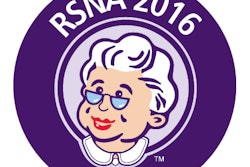Breast imaging software developer Volpara Solutions is touting several studies on volumetric breast imaging and analytics data that were presented at RSNA 2016 in Chicago.
Four studies highlighted the use of Volpara Solutions' breast imaging software tools to provide quantitative metrics, including compression, risk assessment, and other factors.
In one study, Dr. Bennett Battle of the University of Arkansas Medical School presented the connection between VolparaDensity and identifying women with an increased risk of breast cancer. In a cohort of 5,746 patients, women in the top quartiles of volumetric breast density and dense volume had a 120% risk and 190% risk, respectively, of developing breast cancer compared with women with the lowest density. Results demonstrated that automated volumetric mammographic density measurement allows for the identification of women at increased risk of developing breast cancer, the firm said.
In another study, Mayo Clinic investigators used two commercial, automated breast density software tools to validate the Laboratory for Individualized Breast Radiodensity Assessment (LIBRA) automatic breast density estimation software. VolparaDensity and LIBRA showed strong correlations to each other in density measurement, but VolparaDensity better predicted breast cancer risk, Volpara said.
Also, the relationship between the amount of breast compression and screening performance was investigated by Nico Karssemeijer, PhD, and researchers from Nijmegen, the Netherlands. They calculated frequencies of recalls, screen-detected cancers, and interval cancers stratified by compression pressure. The results demonstrate the most cancer detection occurred in the middle ranges of breast compression (between 9.2 kPa and 10.7 kPa). Also, if too much pressure is applied during mammography this may increase interval cancer rates and decrease positive predictive value.
In a scientific exhibit, Woutjan Branderhorst, PhD, and a research team from the Netherlands assessed the accuracy of two methods of estimating the contact area between the breast and the paddle during breast screening. The first method evaluated a real-time measurement of contact area using transparent capacitive indium-tin-oxide foil attached to the paddle. In the second method, the contact area was derived from the image pixel data using VolparaEnterprise software. Both methods showed almost perfect correlation to the manual measurement of contact area, and, thus, both are suitable to accurately calculate average breast compression pressure, according to the vendor.

















